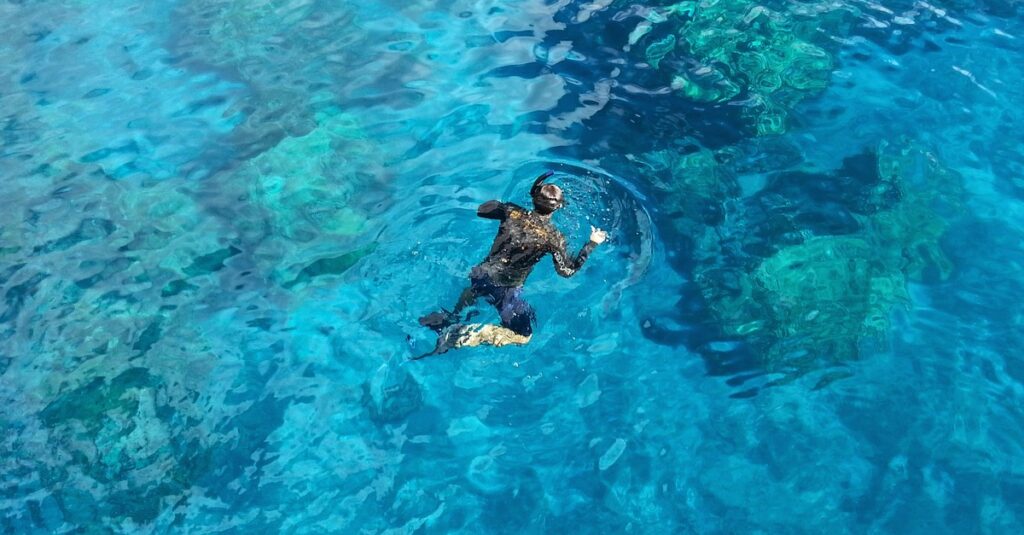

When you begin freediving you should not aim to dive deeply immediately but should focus on fundamental knowledge, techniques and practice to help you dive safely and competently. A depth of 10m is a common achievement targeted on beginner freediving courses.
Beginner freedivers may be curious about how deep they should be diving but depth should not be their primary goal. Thorough instruction and training are recommended for beginners in order to avoid ear, sinus or lung barotrauma (pressure damage), potentially fatal blackouts in the water, or even decompression sickness (the bends). Beginner freediving courses may aim to complete a 10 meter freedive, or similar.
The True Story Book of Freediving Champion Audrey Mestre and the Story of Her Death
View on Amazon: The Last Attempt (Opens new tab)


Top rated read
With the right training and preparation, freediving can be a beginner-friendly sport. It requires little equipment and the participation of only one other person as a diving buddy. Our article tells you more about beginner diving depth, as well as essential freediving knowledge around safety, technique and breath-hold training.
How deep do beginner freedivers go?
An introductory freediving course for beginners might aim to guide participants to successfully complete a freedive of around 10m.
Beginners should not be aiming to go as deep as possible immediately. They must first master and practice essential techniques such as static and dynamic apnea (breath-holding), equalizing pressure in the ears during a dive, and developing mental resilience in the extreme underwater environment.
For more general freediving depths; check out our article on how deep freedivers typically dive (opens new tab).
How do you freedive 10 meters?
Beginner freedivers may start their training in a pool or in a safe and sheltered area of open water with an experienced instructor and buddy. Initial dives are likely to be only a few meters below the surface. Once you have mastered the basics of breath-holding, you can swim gradually deeper for longer and practice equalizing the pressure in the ears.
With practice of static and dynamic apnea techniques you should be able to build up your body’s tolerance to carbon dioxide. When you have the essentials in place, you will soon be able to freedive to 10m.
How do you freedive for beginners?
While anyone can start freediving, getting into the sport without instruction and training can carry serious risks. Learning about freediving safety, human physiology and breath-hold technique is important and a recognized course with a qualified instructor can help you avoid injury and enjoy freediving more. Areas you should cover include:
Static Apnea
Static apnea exercises require you to resist your urge to breathe for as long as possible. When practiced on land, these exercises are termed dry static apnea and this is often the first apnea exercise which beginners will learn. Static apnea is also a competitive freediving discipline and should be practiced regularly in the water.
For dry static apnea practice, you will need carbon dioxide and oxygen breath-hold training tables which guide you systematically through how long to hold your breath and how long to rest between breath-holds.
Before practicing dry or wet static apnea you should do a freediving ‘breathe-up’. This is the term for the breathing process which is used to prepare yourself immediately before a freedive.
For approximately two minutes you should breathe in a calm and measured way, with exhalations twice as long as inhalations. At the end of this breath-up, exhale completely to empty the lungs and take a full inhale to fill your lungs.
This is the point where you then begin to hold your breath and follow the timings in your training tables.
Dynamic Apnea
Dynamic apnea is the term for training exercises or dives carried out while breath-holding. These might be strength building exercises or movement exercises.
Equalizing Pressure
Water pressure at depth can be many times greater than air pressure at sea level. This compresses the volume of air in lungs, sinuses and ears significantly and learning how to equalize the pressure inside the ears is essential to avoid pain and damage to your ears as you freedive. Several techniques can be used for equalizing, with the Frenzel maneuver particularly recommended for freediving.
References
https://www.deeperblue.com/the-science-behind-the-freediving-breath-hold/
https://medicalxpress.com/news/2018-03-free-divers-defied-scienceand-dont.html
